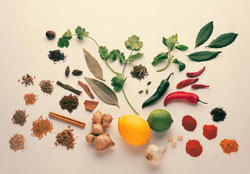Kicking the White Stuff
How to Get More Color (and Health) into Our Diets © Getty Images
© Getty Images
Some years ago, I furtively eyed a couple in a grocery line buying fresh lemons and garlic and tried to imagine the exotic food they would make with such bonafide ingredients. Back then I mostly ate the Standard American Diet (SAD)—prepackaged foods staunchly set in a pale, even ghostly tradition. What nutrition there was in this food had been added back in, in the form of "enrichment." And in lieu of real flavor, the food was heavily laced with fat, sugar and salt—a cheap way, I now see, for manufacturers to keep consumers coming back for more.
When I left white flour behind 15 years ago, it was a deliberate ploy for better health. At first, I continued to crave white flour products. Months down the road, though, I was amazed when a standard issue quesadilla proffered by a friend brought no delight, but instead tasted pasty and overly doughy. I hadn’t quite learned how to mince a fresh clove of garlic—or squeeze juice and scrape zest from a lemon—but I was on my way.
I"m pleased to report a similar epiphany around sugar and its fake counterparts, all of them enticing substances I never thought I would leave behind. But here I am, light years from the land of the white crystal and faux food, eating with the seasons and enjoying the flavors of vegetables and fruits picked at their peak.
Clearly, the mother lode of nutrients and fiber in my colorful, seasonal diet has steadied me. No more do simple sugars and refined carbohydrates jerk my blood sugar levels around like I’m a performer in some bizarre circus. Rather, I go through my days on an even keel and have more energy than I did 20 years ago. And extra pounds that dogged me for years are slipping away.
"Certainly complex carbohydrates and whole grains lead to satiation," said Lola O"Rourke, a registered dietician and spokesperson for the American Dietetics Association. "Considering the obesity problem plaguing this country, foods with some color in them are definitely smart choices."
O"Rourke speaks of complex carbs and colorful foods in the same breath, referring to nature’s palette of vegetables, fruits and whole grains. The benefits of this brightly hued diet are echoed by the U.S. Food and Drug Administration (FDA).
"One of the most important decisions people can make about their health is the choice of foods they eat," says Dr. Scott Gottlieb, the FDA’s Deputy Commissioner for Medical and Scientific Affairs. "A top priority at FDA is finding additional ways to clearly communicate the health benefits found in food."
O"Rourke concurs. "There are just so many reasons to avoid the refined foods and go for whole grains and unprocessed foods with their antioxidants and full complement of vitamins and minerals," she explains. "Even things like flavored yogurts and granola bars that have a healthy aura are really the equivalent of desserts with all their added sugars."
 © Getty Images
© Getty Images
O"Rourke’s critique is aimed not only at foods laced with refined sugar. She also observes that the industrialized food producers often hold values antithetical to our health and well being. "People need to keep in mind that the food marketing machine exists for profits, not health," she explains. "So it’s important to look at the ingredients on the packages when you buy processed foods—and to try and use whole foods more."
Signing, sealing and stamping nature’s bounty has roots in late-19th century industrialization and has been buoyed by U.S. farm policies in the past 50 years. In one farm bill after another, price supports for wheat, soybeans and corn (from which the ubiquitous sweetener high fructose corn syrup comes) have made these commodities cheap. At the same time, relatively little government support has been tendered toward the fresh vegetables and fruits market, where real costs have risen nearly 40 percent over the last 20 years, according to the Institute for Agriculture and Trade Policy (IATP).
"Is it any wonder that people are eating too many calorie-dense foods high in added fats and sugars, and not enough fruits and vegetables?" say Heather Schoonover and Mark Mueller of the IATP’s Environment and Agriculture Program. "Our misguided farm policy is making poor eating habits an economically sensible choice."
Eating Well
And Saving Money
Schoonover and Mueller have a point, but my experience is that when I turned toward whole, fresh, seasonal fare, my food bill dropped precipitously. No longer do I pay the extra 10 percent for packaging costs. Also, I take cues from peasants throughout the history of the world. Instead of buying expensive bakery bread all the time, I stir up things like polenta or put a pan of quick-cooking quinoa with its full amino acid profile on the stove.
I also borrow from Asian and Mediterranean traditions, using fish and meat sparingly in larger vegetable, legume and whole grain dishes. And finally, in place of rich, costly desserts I keep my eye trained on seasonal fruits that are grown as close to my locale as possible. The dear pear. The bold apple. These sweet treasures lend themselves to an array of presentations, whether poached in wine with cinnamon sticks, baked with fresh ginger, or simply sliced and savored with a cheese board or dollop of sour cream produced by a responsible dairy.
Despite a counterproductive mainstream food production system, there is an affordable way to kick the white stuff and move toward a more colorful diet. The transition might be a slow one, but over time eating well can revolutionize our lives: steady our emotions, bring healthful vitality to our bodies and our planet, and even help us trim down.
JEAN JOHNSON is an Oregon-based freelance writer and gardener.

